Road Traffic Noise on the Santa Marta City Tourist Route
Abstract
1. Introduction
2. Materials and Methods
2.1. Study Area
2.2. Traffic Flow Characterization
2.3. Environmental Noise Measurement
2.4. Data Analysis and Statistical Processing
3. Results
3.1. Traffic Flow Characterization
3.2. Environmental Noise
3.3. Statistical Analysis
3.3.1. Analysis of Variance
3.3.2. Pearson Correlation Test
4. Discussion
Supplementary Materials
Author Contributions
Funding
Institutional Review Board Statement
Informed Consent Statement
Data Availability Statement
Acknowledgments
Conflicts of Interest
References
- Branbilla, G. Physical assessment and rating of urban noise. In Environmental Urban Noise; WIT Press: Southampton, UK, 2001; pp. 15–61. [Google Scholar]
- Lebiedowska, B. Acoustic Background and Transport Noise in Urbanised Areas: A Note on the Relative Classification of the City Soundscape. Transp. Res. Part D Transp. Environ. 2005, 10, 341–345. [Google Scholar] [CrossRef]
- Ross, Z.; Kheirbek, I.; Clougherty, J.E.; Ito, K.; Matte, T.; Markowitz, S.; Eisl, H. Noise, Air Pollutants and Traffic: Continuous Measurement and Correlation at a High-Traffic Location in New York City. Environ. Res. 2011, 111, 1054–1063. [Google Scholar] [CrossRef]
- Nugent, C.; Blanes, N.; Fons, J.; Sáinz de la Maza, M.; Ramos, M.; Domingues, F.; van Beek, A.; Houthuijs, D. Noise in Europe 2014; EEA Report; European Environment Agency: Luxembourg, 2014; p. 2014. [Google Scholar]
- Mavrin, V.; Makarova, I.; Prikhodko, A. Assessment of the Influence of the Noise Level of Road Transport on the State of the Environment. Transp. Res. Procedia 2018, 36, 514–519. [Google Scholar] [CrossRef]
- Bravo-Moncayo, L.; Chávez, M.; Puyana, V.; Lucio-Naranjo, J.; Garzón, C.; Pavón-García, I. A Cost-Effective Approach to the Evaluation of Traffic Noise Exposure in the City of Quito, Ecuador. Case Stud. Transp. Policy 2019, 7, 128–137. [Google Scholar] [CrossRef]
- Wallas, A.E.; Eriksson, C.; Bonamy, A.-K.E.; Gruzieva, O.; Kull, I.; Ögren, M.; Pyko, A.; Sjöström, M.; Pershagen, G. Traffic Noise and Other Determinants of Blood Pressure in Adolescence. Int. J. Hyg. Environ. Health 2019, 222, 824–830. [Google Scholar] [CrossRef]
- Wen, X.; Lu, G.; Lv, K.; Jin, M.; Shi, X.; Lu, F.; Zhao, D. Impacts of Traffic Noise on Roadside Secondary Schools in a Prototype Large Chinese City. Appl. Acoust. 2019, 151, 153–163. [Google Scholar] [CrossRef]
- Vogiatzis, K. Strategic Environmental Noise Mapping & Action Plans in Athens Ring Road (Atiiki Odos)—Greece. WSEAS Trans. Environ. Dev. 2011, 7, 315–324. [Google Scholar]
- Ögren, M.; Molnár, P.; Barregard, L. Road Traffic Noise Abatement Scenarios in Gothenburg 2015—2035. Environ. Res. 2018, 164, 516–521. [Google Scholar] [CrossRef]
- Hou, Q.; Leng, J.; Ma, G.; Liu, W.; Cheng, Y. An Adaptive Hybrid Model for Short-Term Urban Traffic Flow Prediction. Phys. A Stat. Mech. Its Appl. 2019, 527, 121065. [Google Scholar] [CrossRef]
- Calvo, J.A.; Álvarez-Caldas, C.; San Román, J.L.; Cobo, P. Influence of Vehicle Driving Parameters on the Noise Caused by Passenger Cars in Urban Traffic. Transp. Res. Part D Transp. Environ. 2012, 17, 509–513. [Google Scholar] [CrossRef]
- Vijay, R.; Sharma, A.; Chakrabarti, T.; Gupta, R. Assessment of Honking Impact on Traffic Noise in Urban Traffic Environment of Nagpur, India. J. Environ. Health Sci. Eng. 2015, 13, 1–10. [Google Scholar] [CrossRef]
- Murphy, E.; King, E. Environmental Noise Pollution: Noise Mapping, Public Health, and Policy; Elsevier: Amsterdam, The Netherlands, 2014; ISBN 978-0-12-411614-6. [Google Scholar]
- Recio, A.; Linares, C.; Banegas, J.R.; Díaz, J. The Short-Term Association of Road Traffic Noise with Cardiovascular, Respiratory, and Diabetes-Related Mortality. Environ. Res. 2016, 150, 383–390. [Google Scholar] [CrossRef] [PubMed]
- Zhang, L.; Gong, J.T.; Zhang, H.Q.; Song, Q.H.; Xu, G.H.; Cai, L.; Tang, X.D.; Zhang, H.F.; Liu, F.-E.; Jia, Z.S.; et al. Melatonin Attenuates Noise Stress-Induced Gastrointestinal Motility Disorder and Gastric Stress Ulcer: Role of Gastrointestinal Hormones and Oxidative Stress in Rats. J. Neurogastroenterol. Motil. 2015, 21, 189–199. [Google Scholar] [CrossRef]
- Wang, F.; Song, X.; Li, F.; Bai, Y.; Han, L.; Zhang, H.; Zhang, F.; Luo, X.; Shen, H.; Zhu, B. Occupational Noise Exposure and Hypertension: A Case-Control Study. J. Public Health Emerg. 2018, 2, 1–7. [Google Scholar] [CrossRef]
- Héritier, H.; Vienneau, D.; Foraster, M.; Eze, I.C.; Schaffner, E.; Thiesse, L.; Ruzdik, F.; Habermacher, M.; Köpfli, M.; Pieren, R.; et al. Diurnal Variability of Transportation Noise Exposure and Cardiovascular Mortality: A Nationwide Cohort Study from Switzerland. Int. J. Hyg. Environ. Health 2018, 221, 556–563. [Google Scholar] [CrossRef]
- Recio, A.; Linares, C.; Díaz, J. System Dynamics for Predicting the Impact of Traffic Noise on Cardiovascular Mortality in Madrid. Environ. Res. 2018, 167, 499–505. [Google Scholar] [CrossRef]
- WHO—World Health Organization. Environmental Noise Guidelines for the European Region; WHO Regional Office for Europe: Copenhagen, Denmark, 2018; ISBN 978-92-890-5356-3. [Google Scholar]
- Del Solar, L.M.; Gallegos, W.L.A.; Salinas, M.A.M. Síndrome de burnout en conductores de transporte público de la ciudad de Arequipa. Rev. Peru. Psicol. Trab. Soc. 2017, 2, 111–122. [Google Scholar]
- Garrido-Galindo, A.P.; Camargo Caicedo, Y.; Vélez-Pereira, A.M. Nivel Continuo Equivalente de Ruido En La Unidad de Cuidado Intensivo Neonatal Asociado al Síndrome de Burnout. Enferm. Intensiva 2015, 26, 92–100. [Google Scholar] [CrossRef]
- Öhrström, E.; Hadzibajramovic, E.; Holmes, M.; Svensson, H. Effects of Road Traffic Noise on Sleep: Studies on Children and Adults. J. Environ. Psychol. 2006, 26, 116–126. [Google Scholar] [CrossRef]
- Fyhri, A.; Aasvang, G.M. Noise, Sleep and Poor Health: Modeling the Relationship between Road Traffic Noise and Cardiovascular Problems. Sci. Total Environ. 2010, 408, 4935–4942. [Google Scholar] [CrossRef] [PubMed]
- Kim, M.; Chang, S.I.; Seong, J.C.; Holt, J.B.; Park, T.H.; Ko, J.H.; Croft, J.B. Road Traffic Noise: Annoyance, Sleep Disturbance, and Public Health Implications. Am. J. Prev. Med. 2012, 43, 353–360. [Google Scholar] [CrossRef] [PubMed]
- Paiva, K.M.; Cardoso, M.R.A.; Zannin, P.H.T. Exposure to Road Traffic Noise: Annoyance, Perception and Associated Factors among Brazil’s Adult Population. Sci. Total Environ. 2019, 650, 978–986. [Google Scholar] [CrossRef] [PubMed]
- Toronto Public Health. Health Effects of Noise; City of Toronto Community and Neighbourhood Services Toronto Public Health Health Promotion and Environment Protection Office: Toronto, ON, Canada, 2000; p. 20. [Google Scholar]
- Chepesiuk, R. Decibel Hell: The Effects of Living in a Noisy World. Environ. Health Perspect. 2005, 113, A34–A41. [Google Scholar] [CrossRef]
- Rubio Alférez, J.; Vanhooreweder, B.; Segués, F.; Kärkkäinen, A.; Giannopoulou, E.; Bellucci, P.; Report Best Practice in Strategic Noise Mapping. CEDR Conference of European Directors of Roads. 2013, p. 36. Available online: http://www.carreteros.org/explotacion/cedr/1_CEDR_august_2013.pdf (accessed on 27 July 2021).
- Istamto, T.; Houthuijs, D.; Lebret, E. Willingness to Pay to Avoid Health Risks from Road-Traffic-Related Air Pollution and Noise across Five Countries. Sci. Total Environ. 2014, 497–498, 420–429. [Google Scholar] [CrossRef]
- Von Graevenitz, K. The Amenity Cost of Road Noise. J. Environ. Econ. Manag. 2018, 90, 1–22. [Google Scholar] [CrossRef]
- Ideam, S.D.E.A. Meteorología, y Estudios Ambientales Documento Soporte Ruido Norma de Ruido Ambiental; IDEAM: Bogotá, Colombia, 2006; p. 268. [Google Scholar]
- Rendón, J.G.; Gómez, J.R.M.; Pardo, A.F.V.; Monsalve, R.A.A. Índices de ruido urbano en el día sin carro en la ciudad de Medellín. Rev. Faculdad Ing. USBMED 2010, 1, 78–85. [Google Scholar] [CrossRef]
- Ramírez González, A.; Domínguez Calle, E.A.; Borrero Marulanda, I. El Ruido Vehicular Urbano y Su Relación Con Medidas de Restricción Del Flujo de Automóviles. Rev. Acad. Colomb. Cienc. Exactas Físicas Nat. 2011, 35, 143–156. [Google Scholar]
- Quintero, J.R.G. Tendencias Actuales En El Estudio y Análisis Del Ruido Producido Por El Tráfico Rodado En Las Ciudades. Intekhnia 2012, 7, 173–192. [Google Scholar]
- Quintero, J.R.G. El ruido del tráfico vehicular y sus efectos en el entorno urbano y la salud humana. Puente 2013, 7. [Google Scholar] [CrossRef]
- Parrondo, J.L.; Velarde, S.; González, J.; Ballesteros, R.; Santolaria, C. Ruido de máquinas y vehículos. In Acústica Ambiental; Universidad de Oviedo: Asturias, Spain, 2006; pp. 123–140. ISBN 978-84-8317-531-6. [Google Scholar]
- Domingo, R.B. Ruido de tráfico. In Acústica Medioambiental; Editorial Club Universitario: San Vicente, Spain, 2010; Volume 1, pp. 233–246. ISBN 978-84-9948-020-6. [Google Scholar]
- Can, A.; Aumond, P. Estimation of Road Traffic Noise Emissions: The Influence of Speed and Acceleration. Transp. Res. Part D Transp. Environ. 2018, 58, 155–171. [Google Scholar] [CrossRef]
- MCIT—Ministerio de Comercio, Industria y Turismo, Perfil Económico de Magdalena. 2013. Available online: http://portalterritorial.gov.co/apc-aa-files/7515a587f637c2c66d45f01f9c4f315c/oee__magdalena_agosto_2013.pdf (accessed on 17 August 2015).
- Secretaria de Infraestructura Víal Departamento del Magdalena Elaboración Del Análisis, Estudio de Factibilidad Para La Liquidación, Distribución y Cobro de La Contribución de Valorización de Primera Fase Del Plan Vial Del Norte Del Departamento Del Magdalena. 2007. Available online: http://www.msv.ada.co/descargas/Informe_final_Sta_Marta.pdf (accessed on 14 December 2014).
- Ministerio de Ambiente, Vivienda y Desarrollo Territorial. Resolución 627 de 2006 por la cual se establece la norma nacional de emisión de ruido y ruido ambiental; Ministerio de Ambiente, Vivienda y Desarrollo Territorial: Bogotá, Colombia, 2006; p. 29. [Google Scholar]
- Garrido-Galindo, A.P.; Camargo Caicedo, Y.; Vélez-Pereira, A.M. Nivel de Ruido En La Unidad de Cuidado Intensivo Adulto: Medición, Estándares Internacionales e Implicancias Sanitarias. Univ. Salud 2015, 17, 163–169. [Google Scholar] [CrossRef][Green Version]
- Vélez-Pereira, A.M.; Camargo, Y. Aerobacterias Staphylococcus sp. en las Unidades de Cuidados Intensivos de un hospital universitario. Rev. Trauma 2012, 23, 183–190. [Google Scholar]
- Vélez-Pereira, A.M.; Camargo, Y. Aerobacterias en las unidades de cuidado intensivo del Hospital Universitario “Fernando Troconis”, Colombia. Rev. Cuba. Salud Pública 2014, 40, 362–368. [Google Scholar]
- Vélez-Pereira, A.M.; Camargo, Y. Análisis de los factores ambientales y ocupacionales en la concentración de aerobacterias en unidades de cuidado intensivo del Hospital Universitario Fernando Troconis, 2009 Santa Marta-Colombia. Rev. Cuid. 2014, 5, 595–605. [Google Scholar] [CrossRef]
- Ramis, J.; Alba, J.; García, D.; Hernández, F. Noise Effects of Reducing Traffic Flow through a Spanish City. Appl. Acoust. 2003, 64, 343–364. [Google Scholar] [CrossRef]
- Paviotti, M.; Vogiatzis, K. On the Outdoor Annoyance from Scooter and Motorbike Noise in the Urban Environment. Sci. Total Environ. 2012, 430, 223–230. [Google Scholar] [CrossRef]
- Duque, M.A.R.; Ladino, E.V. Modelación Matemática del Ruido Producido por el Tráfico en Seis Puntos Ubicados en la Ciudad de Pereira. Bachelor’s Thesis, Universidad Nacional de Colombia, Manizales, Colombia, 2007. [Google Scholar]
- Jakovljevic, B.; Paunovic, K.; Belojevic, G. Road-Traffic Noise and Factors Influencing Noise Annoyance in an Urban Population. Environ. Int. 2009, 35, 552–556. [Google Scholar] [CrossRef]
- Echeverry, Z.; Lucía, C. Un Aporte a La Gestión Del Ruido Urbano En Colombia, Caso de Estudio Municipio de Envigado. Master’s Thesis, Universidad Nacional de Colombia, Manizales, Colombia, 2010. [Google Scholar]
- Quintero González, J.R. Caracterización del ruido producido por el tráfico vehicular en el centro de la ciudad de Tunja, Colombia. Rev. Virtual Univ. Católica Norte 2012, 1, 311–343. [Google Scholar]
- Suthanaya, P.A. Modelling Road Traffic Noise for Collector Road (Case Study of Denpasar City). Procedia Eng. 2015, 125, 467–473. [Google Scholar] [CrossRef]
- Oyedepo, S.O.; Adeyemi, G.A.; Fayomi, O.S.I.; Fagbemi, O.K.; Solomon, R.; Adekeye, T.; Babalola, O.P.; Akinyemi, M.L.; Olawole, O.C.; Joel, E.S.; et al. Dataset on Noise Level Measurement in Ota Metropolis, Nigeria. Data Brief 2019, 22, 762–770. [Google Scholar] [CrossRef] [PubMed]
- López Redondo, L.L. Análisis del Aporte al Ruido Ambiental Emitido por los Vehículos Particulares en Bogotá. Engineering’s Thesis, Universidad de San Buenaventura, Bogotá, Colombia, 2007. [Google Scholar]
- Pacheco, J.; Franco, J.F.; Behrentz, E. Caracterización de los niveles de contaminación auditiva en Bogotá: Estudio piloto. Rev. Ing. 2009, 30, 72–80. [Google Scholar] [CrossRef]
- Yepes, D.L.; Gómez, M.; Sánchez, L.; Jaramillo, A. Metodología de Elaboración de Mapas Acústicos Como Herramienta de Gestión Del Ruido Urbano-Caso Medellín. Dyna 2009, 76, 29–40. [Google Scholar]
- Can, A.; Rademaker, M.; Van Renterghem, T.; Mishra, V.; Van Poppel, M.; Touhafi, A.; Theunis, J.; De Baets, B.; Botteldooren, D. Correlation Analysis of Noise and Ultrafine Particle Counts in a Street Canyon. Sci. Total Environ. 2011, 409, 564–572. [Google Scholar] [CrossRef]
- Casas-García, O.; Betancur-Vargas, C.M.; Montaño-Erazo, J.S. Revisión de la normatividad para el ruido acústico en Colombia y su aplicación. Entramado 2017, 11, 264–286. [Google Scholar] [CrossRef]
- Ibarra, D.; Ramírez-Mendoza, R.; López, E. Noise Emission from Alternative Fuel Vehicles: Study Case. Appl. Acoust. 2017, 118, 58–65. [Google Scholar] [CrossRef]
- Bravo, T.; Ibarra, D.; Cobo, P. Far-Field Extrapolation of Maximum Noise Levels Produced by Individual Vehicles. Appl. Acoust. 2013, 74, 1463–1472. [Google Scholar] [CrossRef]
- Winroth, J.; Kropp, W.; Hoever, C.; Beckenbauer, T.; Männel, M. Investigating Generation Mechanisms of Tyre/Road Noise by Speed Exponent Analysis. Appl. Acoust. 2017, 115, 101–108. [Google Scholar] [CrossRef]
- Jaramillo, A.; González, A.; Betancur, C.; Correa, M. Estudio Comparativo Entre Las Mediciones de Ruido Ambiental Urbano a 1,5 m y 4 m de Altura Sobre El Nivel Del Piso En La Ciudad de Medellín, Antioquia—Colombia. DYNA 2009, 76, 71–79. [Google Scholar]
- Harris, C.M. Manual de Medidas Acústicas y Control Del Ruido, 3rd ed.; McGraw-Hil: Madrid, Spain, 1995; Volume 1, ISBN 84-481-1619-4. [Google Scholar]
- O’Malley, V.; King, E.; Kenny, L.; Dilworth, C. Assessing Methodologies for Calculating Road Traffic Noise Levels in Ireland—Converting CRTN Indicators to the EU Indicators (Lden, Lnight). Appl. Acoust. 2009, 70, 284–296. [Google Scholar] [CrossRef]
- Sandoval, A.M. Ruido Por Tráfico Urbano: Conceptos, Medidas Descriptivas y Valoración Económica. Econ. Adm. 2005, 2, 1–49. [Google Scholar]
- Calixto, A.; Diniz, F.B.; Zannin, P.H.T. The Statistical Modeling of Road Traffic Noise in an Urban Setting. Cities 2003, 20, 23–29. [Google Scholar] [CrossRef]
- Platzer, U.; Iñiguez, R.; Cevo, J.; Ayala, F. Medición de Los Niveles de Ruido Ambiental En La Ciudad de Santiago de Chile. Rev. Otorrinolaringol. Cir. Cabeza Cuello 2007, 67, 122–128. [Google Scholar] [CrossRef]
- Jiménez-Uribe, D.A.; Daniels, D.; González-Álvarez, Á.; Vélez-Pereira, A.M. Influence of Vehicular Traffic on Environmental Noise Spectrum in the Tourist Route of Santa Marta City. Energy Rep. 2020, 6, 818–824. [Google Scholar] [CrossRef]
- Bohatkiewicz, J. Noise Control Plans in Cities—Selected Issues and Necessary Changes in Approach to Measures and Methods of Protection. Transp. Res. Procedia 2016, 14, 2744–2753. [Google Scholar] [CrossRef]
- Bunn, F.; Zannin, P.H.T. Urban Planning-Simulation of Noise Control Measures. Noise Control Eng. J. 2015, 63, 1–10. [Google Scholar] [CrossRef]
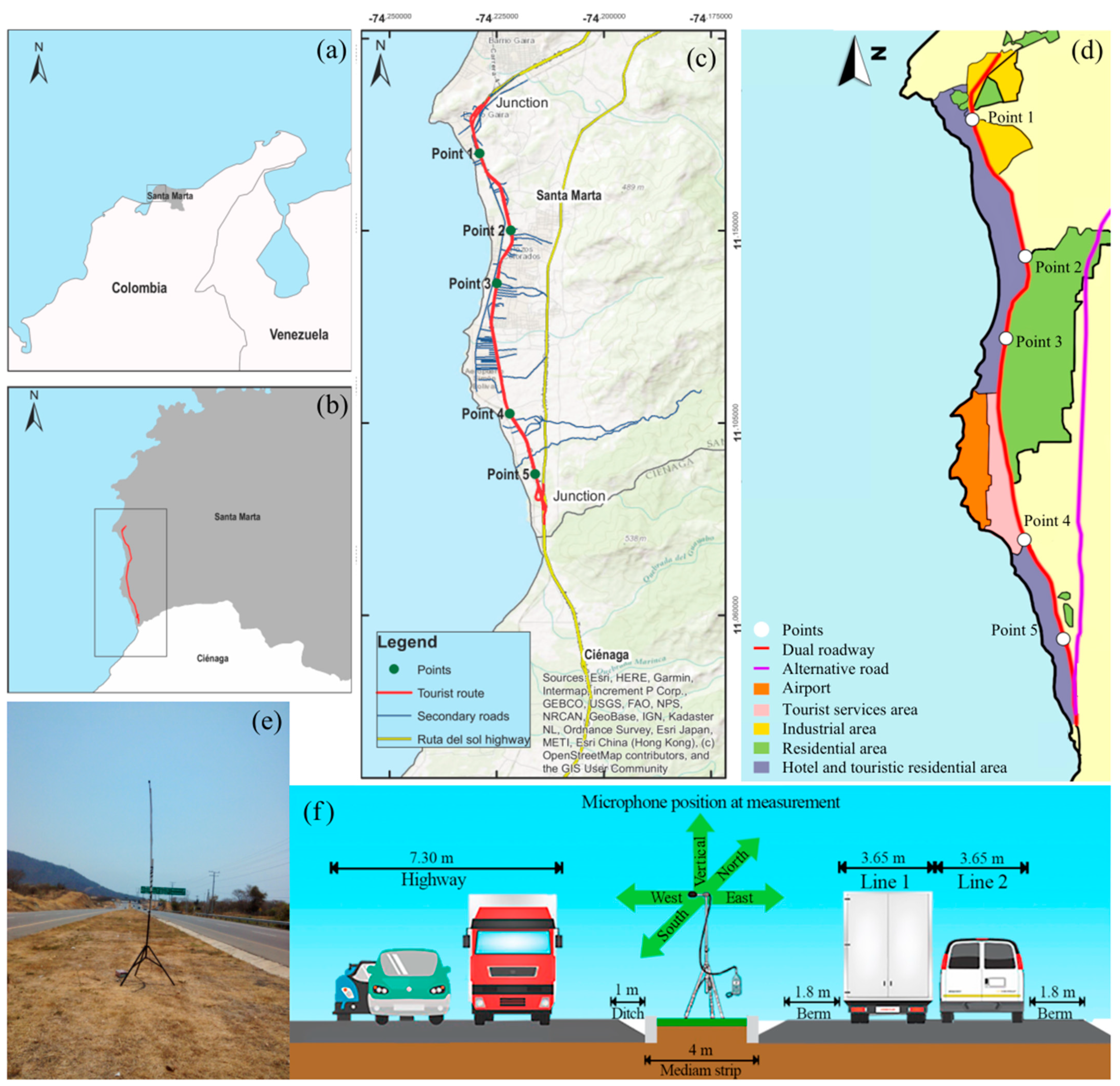

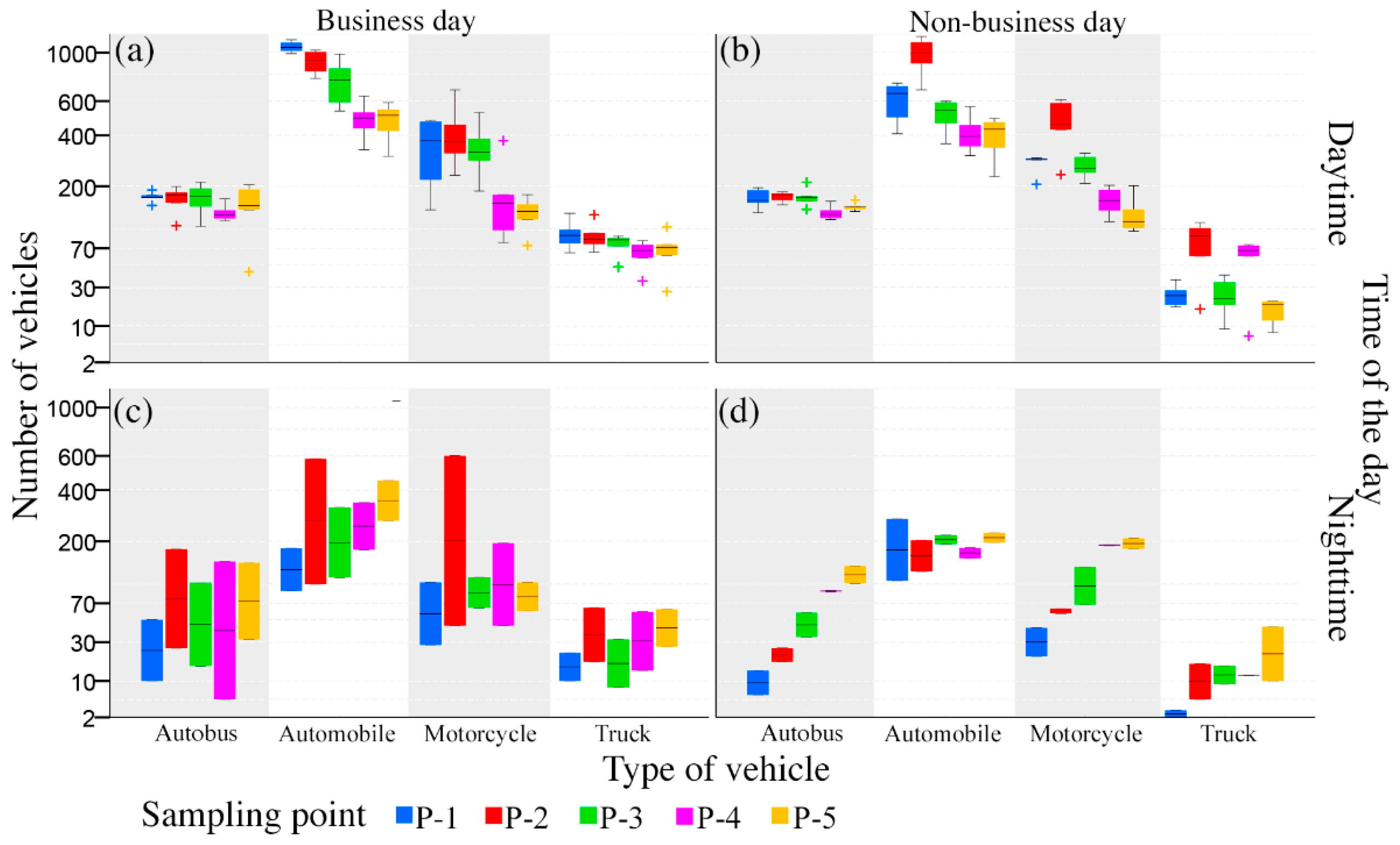
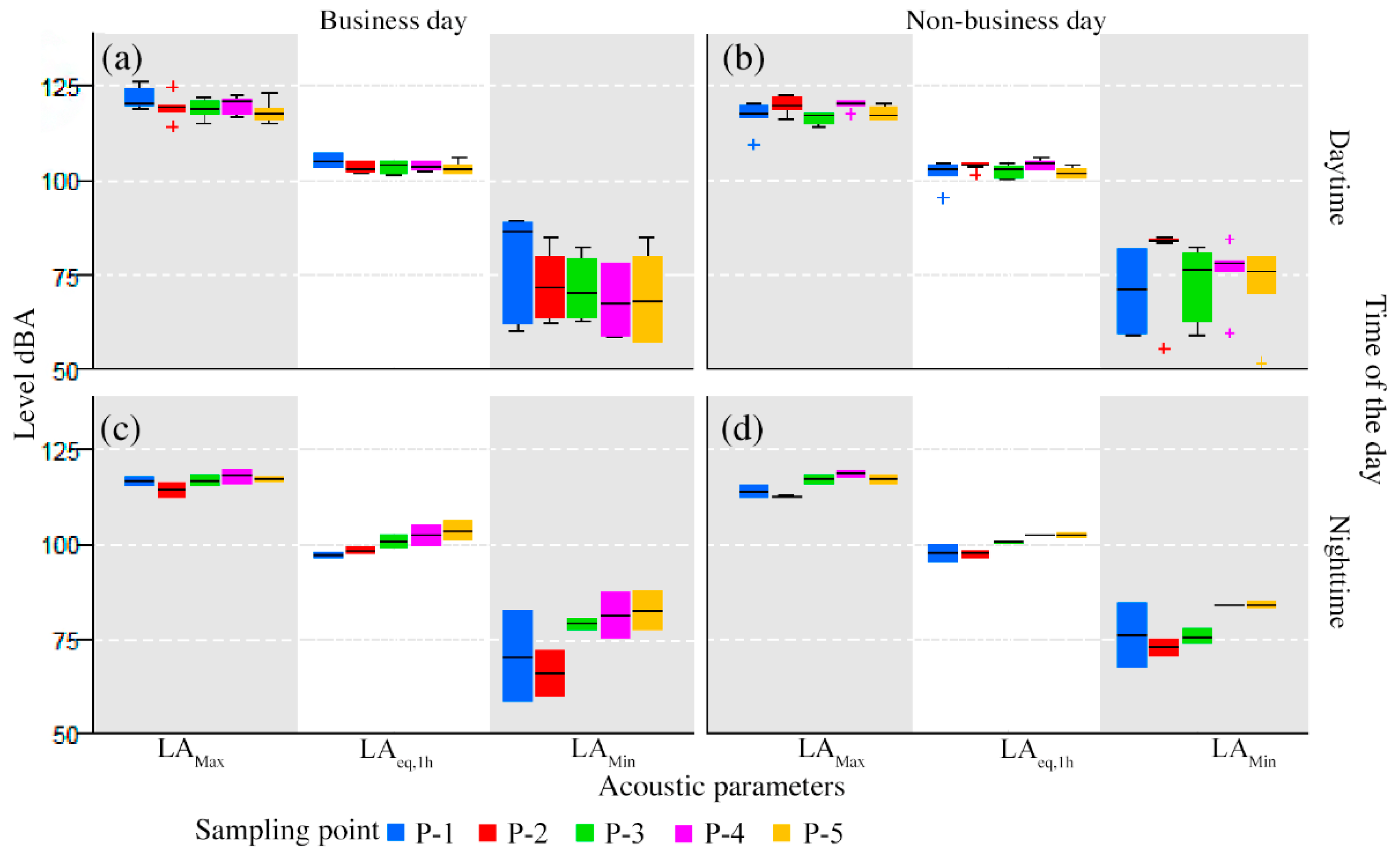

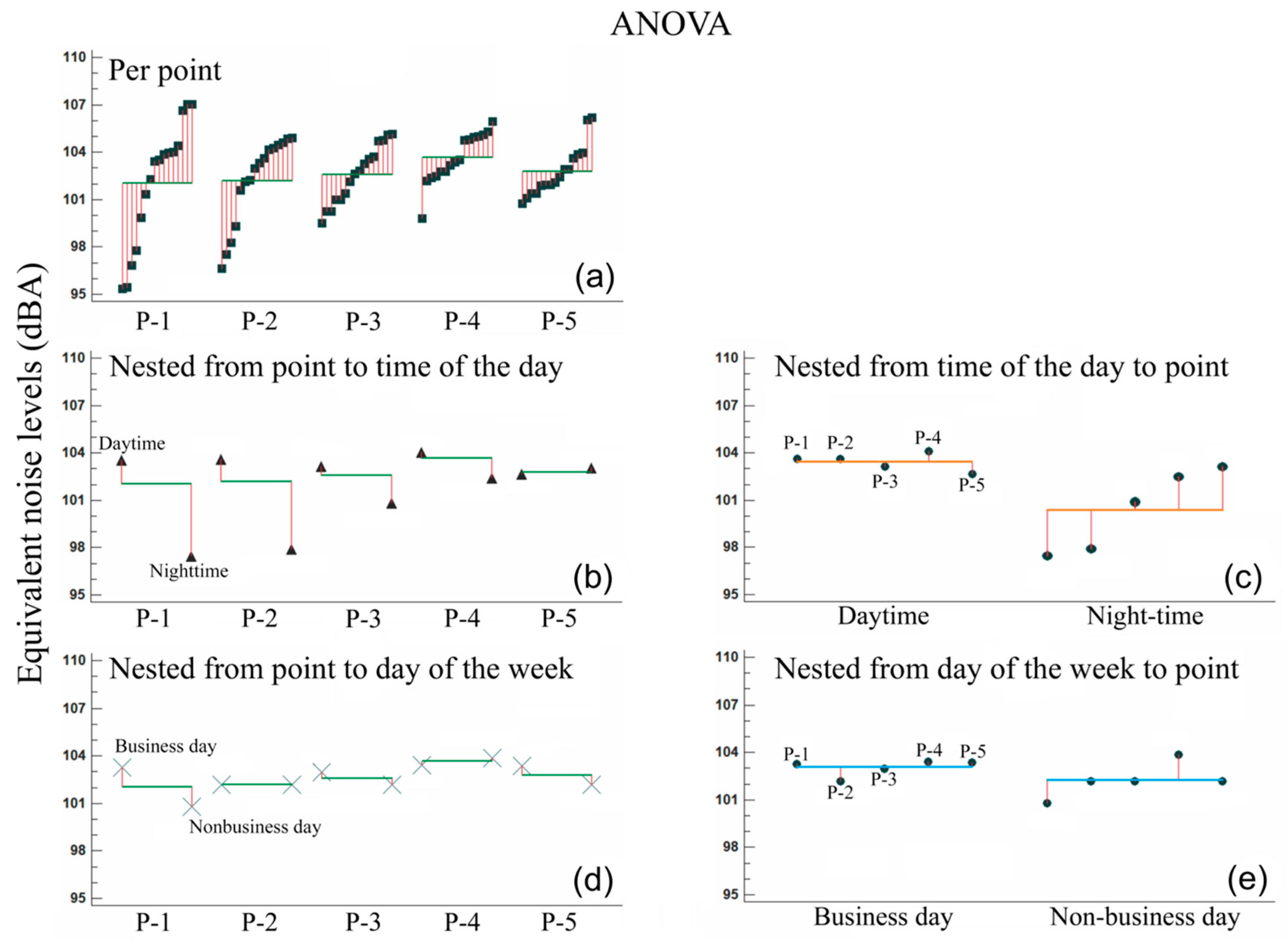
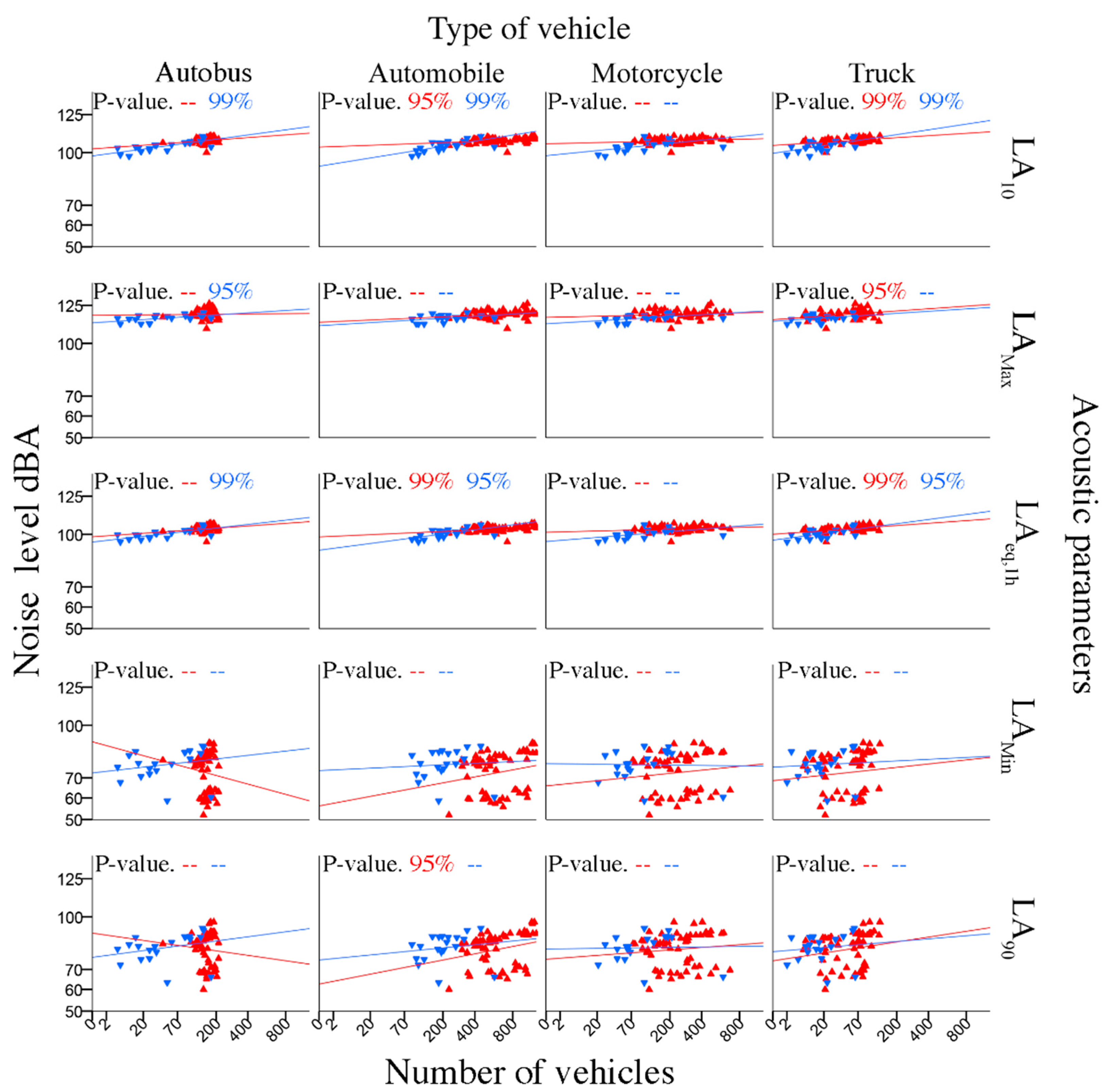
Publisher’s Note: MDPI stays neutral with regard to jurisdictional claims in published maps and institutional affiliations. |
© 2021 by the authors. Licensee MDPI, Basel, Switzerland. This article is an open access article distributed under the terms and conditions of the Creative Commons Attribution (CC BY) license (https://creativecommons.org/licenses/by/4.0/).
Share and Cite
Jiménez-Uribe, D.A.; Daniels, D.; Fleming, Z.L.; Vélez-Pereira, A.M. Road Traffic Noise on the Santa Marta City Tourist Route. Appl. Sci. 2021, 11, 7196. https://doi.org/10.3390/app11167196
Jiménez-Uribe DA, Daniels D, Fleming ZL, Vélez-Pereira AM. Road Traffic Noise on the Santa Marta City Tourist Route. Applied Sciences. 2021; 11(16):7196. https://doi.org/10.3390/app11167196
Chicago/Turabian StyleJiménez-Uribe, Dámaris A., Darwin Daniels, Zoë L. Fleming, and Andrés M. Vélez-Pereira. 2021. "Road Traffic Noise on the Santa Marta City Tourist Route" Applied Sciences 11, no. 16: 7196. https://doi.org/10.3390/app11167196
APA StyleJiménez-Uribe, D. A., Daniels, D., Fleming, Z. L., & Vélez-Pereira, A. M. (2021). Road Traffic Noise on the Santa Marta City Tourist Route. Applied Sciences, 11(16), 7196. https://doi.org/10.3390/app11167196








